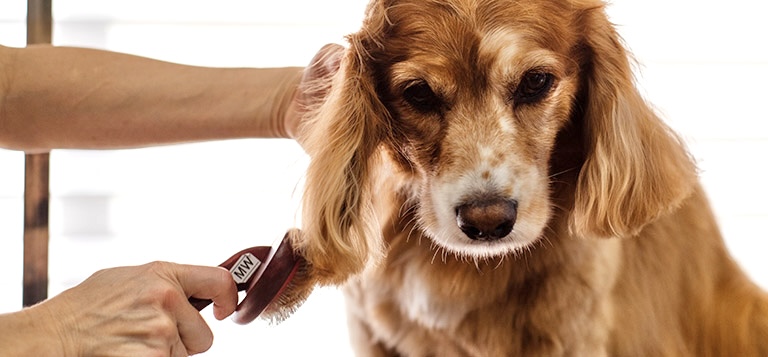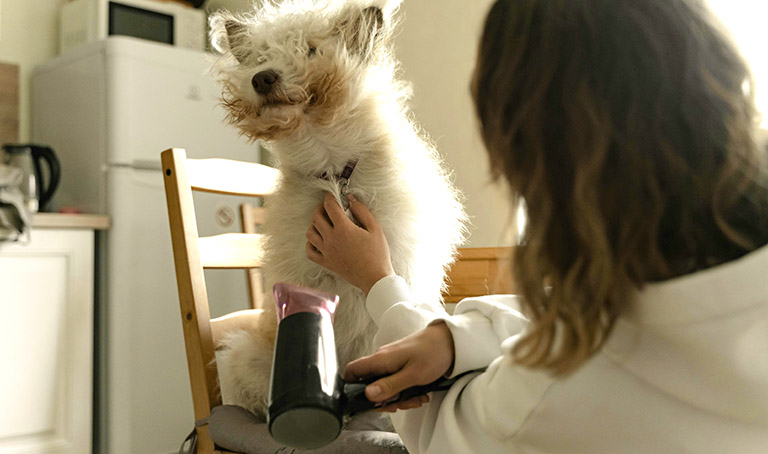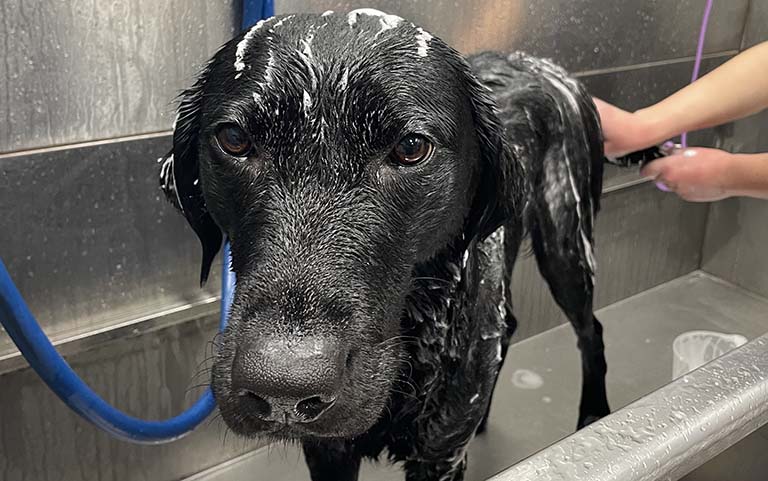Winter demands extra care in your dog’s bathing routine, requiring more thoughtful consideration than the warmer months. While you don’t have to be an expert, having a well-planned approach can greatly improve the bathing experience for both you and your furry friend.
This blog covers essential tips for winter dog baths, ranging from setting an early bath time to shampoo selection and paw inspections. By following these recommendations, you can ensure that your pooch not only finds the process enjoyable but also emerges from the experience happy and clean.
Set an Early Bath Time
For optimal comfort, schedule your dog’s bath in the morning. By completing the bath early in the day, you give your furry companion ample time for the drying process, ensuring that by early evening, their coat is entirely dry. This strategic timing enhances your dog’s post-bath well-being and minimizes exposures to cold temperatures during the drying phase.

Take a Potty Break First
Prior to giving your dog a bath, be sure to take them out for a potty break. Bath time can induce stress or excitement in dogs, potentially leading to them going to the bathroom in the tub or on the floor. It also can increase the need to go outside in the cold to relieve themselves. Taking this precautionary step helps prevent both cold exposure and accidents, fostering a positive and stress-free bathing experience for your dog.
Brush and Comb Before Bathing
Before subjecting your dog to a bath, it’s crucial to ensure their coat is free from any tangles. Wetting tangled fur can increase the issue, causing knots to become tighter, larger and more challenging to manage during the post-bath brushing and combing process. This unfortunate outcome often leads to matting, a condition that may necessitate shaving your dog’s coat for relief from the entangled hair.
In winter, dogs with longer coats, particularly those sporting double coats, are at a higher risk of developing mats and tangles. A double coat consists of two layers that grow independently, typically differing in texture and length – usually a rough top coat paired with a soft undercoat. Breeds such as huskies, chows, Labrador retrievers, corgis and border collies are examples of dogs with this dual-layered fur structure.
The presence of snow and ice during their outdoor activities can contribute to these issues, as the frozen elements tend to become entwined with the fur. By addressing tangles before the bath, you not only maintain the aesthetic appeal of your dog’s coat but also decrease the potential for post-bath grooming challenges, ensuring a smoother and more comfortable grooming experience for both you and your furry companion.

Create a Warm Environment
Opting for warm baths not only keeps your pet comfortable but also plays a crucial role in maintaining a healthy and warm body temperature for them. Enhance the overall warmth for your dog by adjusting the house thermostat up by a degree or two, ensuring they don’t feel chilly after their bath.
The optimal water temperature for your dog’s bath in winter is approximately 90-98 degrees Fahrenheit. It is a good idea to go cooler if your dog has been exercising before they started their bath. Before subjecting your pet to the bath, test the water temperature on your own skin to ensure it is comfortable and safe for your dog. This helps create a soothing and enjoyable bathing experience while prioritizing your dog’s well-being.
Choose Shampoo Wisely
When selecting a shampoo for your dog, choose one that suits their specific needs. If your dog is susceptible to dry skin or dandruff, opt for a shampoo containing soothing ingredients like oatmeal, shea butter, coconut oil and aloe vera.
Oatmeal provides relief from dryness and itching, shea butter moisturizes the skin, coconut oil combats dryness and aloe vera offers soothing and healing properties. These ingredients work together to maintain a healthy and moisturized coat, addressing specific skin concerns and promoting overall skin health for your furry companion. Remember to thoroughly rinse after lathering to ensure the best results.

Don’t Forget the Paws
Winter brings challenges for your dog’s paw care, as snow, ice and salt easily accumulate between their pads. Take advantage of bath time to thoroughly clean their paws. Begin by gently soaking their paws in lukewarm water and using a mild shampoo for washing. This not only removes debris but also provides an opportunity to assess the health of their paws. Properly dry their paws afterwards to prevent any issues associated with moisture accumulation.
Look out for any signs of damage caused by the cold weather, such as sensitivity to snow and ice or irritation from salt. Regular paw checks during bath time can help your furry friend’s feet stay in good condition throughout the winter months.
Use the Right Drying Tools
After bath time, expect your dog to indulge in a good shake; however, it’s essential to expedite the drying process using a thick, absorbent towel. This not only prevents them from catching a chill but also efficiently removes moisture. Towel drying ensures your furry companion is ready for outdoor adventures sooner.
If you choose to employ a blow dryer, exercise caution by selecting the lowest temperature setting and keeping it at least seven inches from your dog’s coat to prevent any risk of burns. Always test the heat on yourself before using it on your dog. Prioritizing a gentle and safe drying approach contributes to your dog’s overall comfort and well-being after their bath.

Embracing a Winter Grooming Regimen for Your Dog
As the winter chill settles in, providing your dog with a comforting and enjoyable bath experience becomes an essential aspect of their care routine. Establishing an early bath time, incorporating a potty break and creating a warm environment contribute significantly to a positive bathing experience. Additionally, practices such as brushing, choosing the right shampoo, paw cleaning and using appropriate drying tools are essential for a thorough bath.
Embrace these winter grooming rituals, and witness your dog revel in the warmth and care provided, creating a harmonious balance between cleanliness and canine contentment throughout the winter months.
For more in-depth tips for a successful bath time with your canine friend, read this blog.


